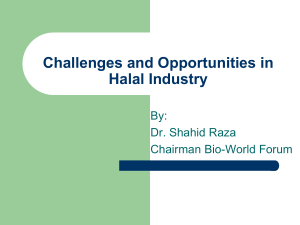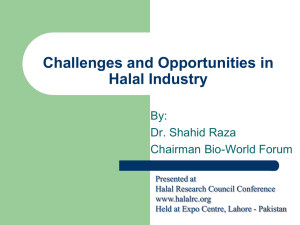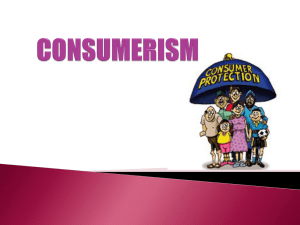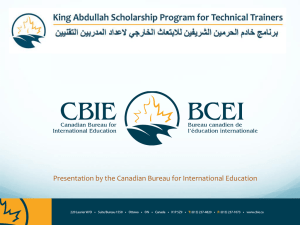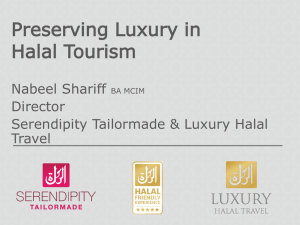- University of Greenwich
advertisement
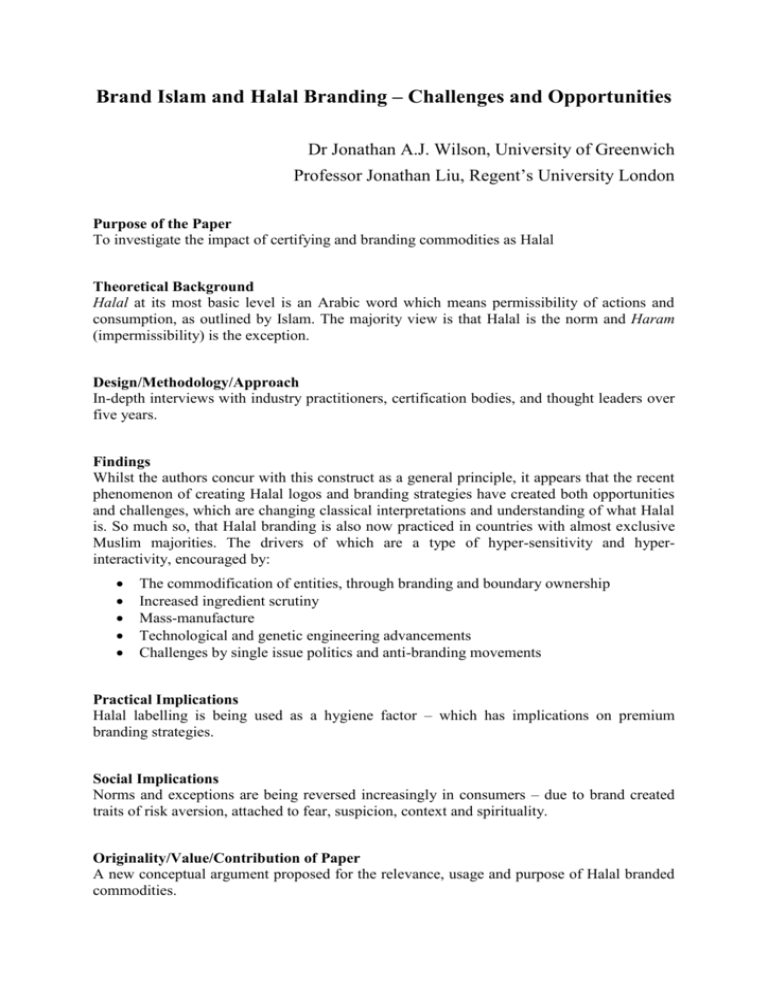
Brand Islam and Halal Branding – Challenges and Opportunities Dr Jonathan A.J. Wilson, University of Greenwich Professor Jonathan Liu, Regent’s University London Purpose of the Paper To investigate the impact of certifying and branding commodities as Halal Theoretical Background Halal at its most basic level is an Arabic word which means permissibility of actions and consumption, as outlined by Islam. The majority view is that Halal is the norm and Haram (impermissibility) is the exception. Design/Methodology/Approach In-depth interviews with industry practitioners, certification bodies, and thought leaders over five years. Findings Whilst the authors concur with this construct as a general principle, it appears that the recent phenomenon of creating Halal logos and branding strategies have created both opportunities and challenges, which are changing classical interpretations and understanding of what Halal is. So much so, that Halal branding is also now practiced in countries with almost exclusive Muslim majorities. The drivers of which are a type of hyper-sensitivity and hyperinteractivity, encouraged by: The commodification of entities, through branding and boundary ownership Increased ingredient scrutiny Mass-manufacture Technological and genetic engineering advancements Challenges by single issue politics and anti-branding movements Practical Implications Halal labelling is being used as a hygiene factor – which has implications on premium branding strategies. Social Implications Norms and exceptions are being reversed increasingly in consumers – due to brand created traits of risk aversion, attached to fear, suspicion, context and spirituality. Originality/Value/Contribution of Paper A new conceptual argument proposed for the relevance, usage and purpose of Halal branded commodities. Background There has been a revival in the ancient Muslim tradition of commerce along the silk roads and spice trade routes. More recently, its reach has expanded with Muslim majority and minority geographies, diaspora, and converts giving birth to a phenomenon that Wilson (2014) terms ‘Brand Islam’. This is where an overtly labeled Islamic identity linked to brands is important to Muslims – as part of their own identity formation alongside those of products and services that they consume. In 2010, Miles Young, Global CEO of Ogilvy, described Muslims as the "third one billion" in terms of market opportunity, and of more significance than the Indian and Chinese billions. One quarter of the world's population are Muslim, and growing, with well over half of Muslims today under the age of 25. When considering the acronyms for the emerging economies to watch: in 2001 it was BRIC (Brazil, Russia, India, and China); and more recently in 2013 MINT (Mexico, Indonesia, Nigeria, Turkey), and CIVETS (Columbia, Indonesia, Vietnam, Egypt, Turkey and South Africa) – then it is apparent that economies with large Muslim populations are growing in importance. Previously, these relevant issues were addressed often under banners of multicultural, ethnic, or international marketing. However, the argument here is that such bodies of work struggle when reflecting enough of the nuances associated with Muslim consumption patterns, doing business in Muslim markets, and targeting Muslim consumers. Paper and presentation overview The authors will tackle this topic through considering the significance of culture and its impact on Halal consumption and consumerism. Their aim is to share conceptual arguments derived from findings concerning the impact of certifying and branding commodities as Halal, and the growing usage of Halal branding beyond food and finance (meat and money). Their work draws from continuing iterative in-depth interviews with industry practitioners, certification bodies, and thought leaders over the past five-years. At its most basic level Halal is an Arabic word which means permissibility of actions and consumption, as outlined by Islam. The majority view is that Halal is the norm and Haram (impermissible actions and consumption), or non-Halal, is the exception. Whilst scholars concur with this construct as a general principle, the authors argue that the recent phenomenon of creating Halal logos and branding strategies have created both opportunities and challenges, which are changing classical interpretations and understanding of what Halal is. So much so, that Halal branding is also now practiced in countries with almost exclusive Muslim majorities. The drivers of which are a type of hyper-sensitivity and hyperinteractivity, encouraged by: the commodification of entities, through branding and boundary ownership; increased ingredient scrutiny; mass-manufacture; technological and genetic engineering advancements; challenges by single issue politics and anti-branding movements. Halal labelling is being used both as a hygiene factor and a badge celebrating an Islamic identity—the implications of which poses challenges to branding strategies. Norms and exceptions are being reversed increasingly in consumers—due to brand created traits of risk aversion, attached to fear, suspicion, context and spirituality. A focus of the presentation is to encourage new conceptual arguments of relevance and practical use when creating Halal branded commodities. Background References Wilson, J.A.J. (2014), “Revisiting the philosophical arguments underpinning Islamic finance and Halal”, Whitepaper, Thomson Reuters Zawya, March 10th, http://www.zawya.com/story/Islamic_Finance_Gateway_Revisiting_the_philosophical_arguments_under pinning_Islamic_finance_and_Halal__By_Dr_Jonathan_Wilson-pdf_060314122451/ Wilson, J.A.J. (2014), “Brand Islam is fast becoming the new black in marketing terms”, Guardian Media Network, February 18th, http://www.theguardian.com/media-network/media-networkblog/2014/feb/18/islamic-economy-marketing-branding Wilson, J.A.J. (2013), “The Halal Value System”, 9 th World Islamic Economic Forum (WIEF), October, PricewaterhouseCoopers (PwC) Malaysia. Wilson, J.A.J. (2013), “Branding the Halal Industry”, Global Islamic Finance Report (GIFR), London: Edbiz Consulting. Wilson, J.A.J. (2013), “Consumer Behaviour as I see it”, [Exhibit], in Solomon, M., Bamossy, G., Askegaard, S. & Hogg, M. (2013), Consumer Behaviour – A European Perspective, 5th ed., Harlow, Essex: Pearson Higher Education. Wilson, J.A.J., Belk, R.W., Bamossy, G.J., Sandikci, O., Kartajaya, H., Sobh, R., Liu, J. & Scott, L. (2013), “Crescent Marketing, Muslim Geographies and Brand Islam: Reflections from the JIMA Senior Advisory Board”, Journal of Islamic Marketing, Vol.4 Iss.1, pp.22-50. Wilson, J.A.J. & Grant, J. (2013), “Islamic Marketing – a challenger to the classical marketing canon?”, Journal of Islamic Marketing, Vol.4 Iss.1, pp.7-21. Wilson, J.A.J. & Liu, J. (2011), “The Challenges of Islamic Branding: navigating Emotions and Halal”, Journal of Islamic Marketing, Vol.2 Iss.1, pp.28-42. Wilson, J.A.J & Liu, J. (2010), “Shaping the Halal into a brand?”, Journal of Islamic Marketing, Vol.1 Iss.2., pp.107-123.
